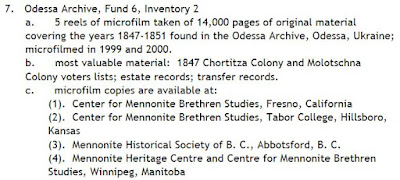Soviet archivists prepared a finding guide containing the description of every file, and someone has translated them into English and/or German. These finding guides are hosted online by the Mennonite Heritage Centre in Winnipeg with one guide for each "inventory."
Now a word about Soviet archival practice. The materials at a Soviet archive are grouped into fondy, which is usually translated "fund" or "fond," which gathers similar materials together. The fond that I used from the Odessa Archive is #6, which I believe is the records of the Guardianship Board for Foreign Settlers, which oversaw the Mennonites and other foreign settlers in Russia. The fond is then divided into opisi, which is usually translated "inventory." The inventory that I used was #2. Finally, individual matters are in folders called dela, or "files." The voting list was in file #11792. So if I wanted to quickly identify this file, I would say "Odessa 6-2-11792."
So how to access the files? You could go to Odessa, Ukraine, and visit the archive; but since that is not convenient for most of us, some wealthy Mennonites have generously paid to have the files microfilmed and deposited in archives in the US. You can find out where the microfilm of a particular set of documents may be viewed by going to Tim Janzen's website on Russian Mennonite genealogy, and scrolling down to Section R, Microfilm Collections. You would note the Fond 6, Inventory 2 is #7 on his list, and it may be found at Hillsboro, Fresno, Abbotsford, and Winnipeg. Since the Center for Mennonite Brethren Studies at Tabor College in Hillsboro, Kansas, is only a block away from my house, I dropped by for a visit.
How did I know what was interesting among the 14,000 pages of materials? I went through the finding guide line by line until I found this gem:
When I go through the finding guides, I look for three categories of records. One is general lists, such as the one above, that have many Mennonites names in them. Usually I can find many ancestors in there. Second, I look for files about specific ancestors - for instance, I found the passport file for my 4-greats grandfather Johann Sudermann, who went back to Prussia in the 1840s to settle his father's inheritance. Finally, I look for more specific items that might mention my ancestors. For example, one file on my list to check is a list of those with contracts to herd sheep for the villages - I wonder if some of my non-landowning ancestors might have herded sheep to survive.
When you dive into the Odessa archival files, I would encourage you to start with inventory 1 because the finding guide is a searchable PDF (some of them are not searchable), in English, and nicely formatted. Make a list of all your direct ancestors who lived in Russia and their villages (if you know them) to help you as you search. Also remember that there is a lot of chaff to sort through in the finding guide, stuff that is not relevant to you. In a 30-page finding guide, you might only find 4-5 items that interest you, so don't give up too soon. Don't hesitate on this one - there are real treasures here that very few people know about.


No comments:
Post a Comment